if 10,000 J of energy fall on piece of land , then what is enrergy at T2 levels ?
1000 J
10 J
100 J
1 J
The correct Answer is:A
To solve the question of how much energy is available at the T2 level when 10,000 J of energy falls on a piece of land, we can follow these steps:
1. Understand the 10% Law: The 10% law in ecology states that when energy is transferred from one trophic level to the next, only about 10% of the energy is passed on. The remaining 90% is lost primarily through metabolic processes as heat.
2. Identify the Initial Energy: In this case, the initial energy falling on the land is 10,000 J. This energy is primarily utilized by producers (like plants) at the first trophic level (T1).
3. Calculate Energy at T2 Level: Since the energy transferred to the next trophic level (T2) is only 10% of the energy available at T1, we can calculate it as follows:
Energy at T2=Energy at T1×10%
Energy at T2=10,000J×0.10=1,000J
4. Conclusion: The energy available at the T2 level is 1,000 J.
Final Answer:
The energy at T2 levels is 1,000 J.
---
Energy at T2=Energy at T1×10%
Energy at T2=10,000J×0.10=1,000J
The energy at T2 levels is 1,000 J.
Topper's Solved these Questions
- BOOK - AAKASH INSTITUTECHAPTER - ECOSYSTEMEXERCISE - Assignment (Section B)35videos
ECOSYSTEM
- BOOK - AAKASH INSTITUTECHAPTER - ECOSYSTEMEXERCISE - Assignment (Section C)65videos
ECOSYSTEM
- BOOK - AAKASH INSTITUTECHAPTER - ECOSYSTEMEXERCISE - Exercise20videos
ECOSYSTEM
- BOOK - AAKASH INSTITUTECHAPTER - DIGESTION AND ABSORPTION EXERCISE - Assignment (SECTION-D Assertion - Reason Type Questions )10videos
DIGESTION AND ABSORPTION
- BOOK - AAKASH INSTITUTECHAPTER - ENVIRONMENTAL ISSUESEXERCISE - ASSIGNMENT SECTION D15videos
ENVIRONMENTAL ISSUES
Similar Questions
Food chains are very important for the survival of most species
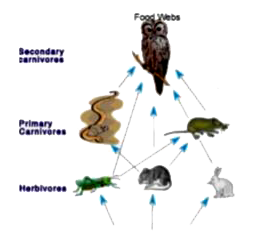
If 10,000 J solar energy falls on green plants in a terrestrial ecosystem, what percentage of solar energy will be converted into food energy?View SolutionIf 200 J of energy is present at the plant level, then the amount of energy received by the eagle will be
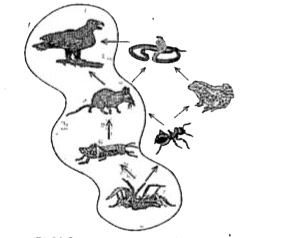 View Solution
View Solution
Knowledge Check
- Question 1 - Select One
If 10,000 J of energy is present at the T1 level, then what is the energy available at the T2 level ?
A1000 JB10 JC100 JD1 J - Question 2 - Select One
An ecosystem recieves 1,000,000 joule of incident-solar energy, then what is the energy available for primary producer level ?
A10,000 JouleB1,00,000 JouleC1000 JouleD100 Joule
If 1,000,000 J of sunlight is provided to a food chain what is the amount of energy is present a top consumer level is food chain have four trophic level.
View SolutionFood chains and the energy flow within an ecosystem provide an important understanding of contingencies and mutual dependencies of organisms. The given below flow chart depicts the energy flow within some members of a grassland ecosystem. The grass in the below ecosystem transducer 120,000 J of sunlight and fixes it into 12,000 J of energy. It is established that 90% of the energy of one trophic level is not passed to the next trophic level. Further assume that the energy transferred from one trophic level to the next is equally shared among the different organisms at that trophic level.
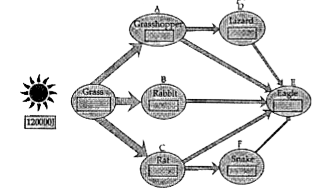
Based on the above information, indicate the amount of energy that an organism C may have received from an organism from the previous trophic level.View SolutionFood chains and the energy flow within an ecosystem provide an important understanding of contingencies and mutual dependencies of organisms. The given below flow chart depicts the energy flow within some members of a grassland ecosystem. The grass in the below ecosystem transducer 120,000 J of sunlight and fixes it into 12,000 J of energy. It is established that 90% of the energy of one trophic level is not passed to the next trophic level. Further assume that the energy transferred from one trophic level to the next is equally shared among the different organisms at that trophic level.
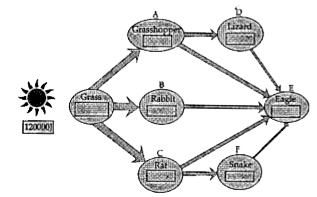
Tropic levels are formed by which of the following components?View SolutionFood chains and the energy flow within an ecosystem provide an important understanding of contingencies and mutual dependencies of organisms. The given below flow chart depicts the energy flow within some members of a grassland ecosystem. The grass in the below ecosystem transducer 120,000 J of sunlight and fixes it into 12,000 J of energy. It is established that 90% of the energy of one trophic level is not passed to the next trophic level. Further assume that the energy transferred from one trophic level to the next is equally shared among the different organisms at that trophic level.
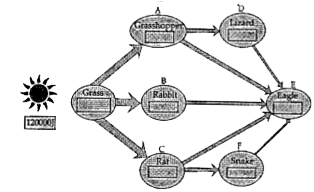
In the food web depicted above, identify the most energy efficient link for tertiary consumer.View SolutionFood chains and the energy flow within an ecosystem provide an important understanding of contingencies and mutual dependencies of organisms. The given below flow chart depicts the energy flow within some members of a grassland ecosystem. The grass in the below ecosystem transducer 120,000 J of sunlight and fixes it into 12,000 J of energy. It is established that 90% of the energy of one trophic level is not passed to the next trophic level. Further assume that the energy transferred from one trophic level to the next is equally shared among the different organisms at that trophic level.
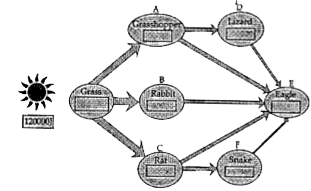
How many food chains are present in the food web depicted above?View SolutionFood chains and the energy flow within an ecosystem provide an important understanding of contingencies and mutual dependencies of organisms. The given below flow chart depicts the energy flow within some members of a grassland ecosystem. The grass in the below ecosystem transducer 120,000 J of sunlight and fixes it into 12,000 J of energy. It is established that 90% of the energy of one trophic level is not passed to the next trophic level. Further assume that the energy transferred from one trophic level to the next is equally shared among the different organisms at that trophic level.
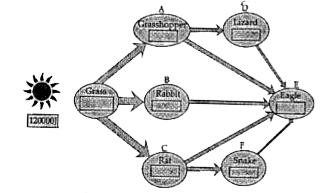
Which organism acts as both the secondary consumer and the tertiary consumer?View Solution

